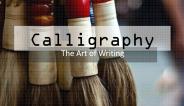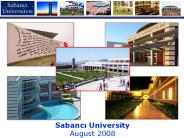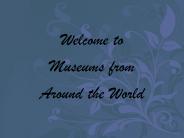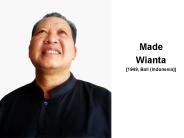Japanese Calligraphy Art PowerPoint PPT Presentations
All Time
Recommended
Chapter 8 Section 2 Visual Art, Architecture, & Performing Arts in Japan By Ana s Teyton, Selena Ortega, & Miharu Sugie Visual Arts Popular: painting, calligraphy ...
| PowerPoint PPT presentation | free to view
What is Shodo? Shodo is Japanese Calligraphy. Shodo is an art form where an ink-dipped brush is used to artistically write Japanese characters.
| PowerPoint PPT presentation | free to view
The Museum built its comprehensive collection of Japanese art beginning in the early 1880s, when it owned just a small, eclectic array of Japanese decorative arts
| PowerPoint PPT presentation | free to view
Japanese Art Cultural Influences The Japanese have been influenced by many different cultures including the Chinese, Koreans and Europeans. However these influences ...
| PowerPoint PPT presentation | free to view
Early Japanese Art
| PowerPoint PPT presentation | free to view
The word "calligraphy" itself is derived from the Greek words meaning "beauty" and "writing".Samples of calligraphy date as far back as 200 BC.Being a unique skill, it pays off to learn how to write calligraphy. Different styles of calligraphy originate from diverse culture old English calligraphy alphabet or Arabic calligraphy alphabet. Islamic has evolved alongside the religion of Islam and the Arabic language. it is associated with geometric Islamic art on the walls and ceilings of mosques as well as on the page.The oldest Chinese characters still existent are Jiǎgǔwén characters carved on ox scapula. Surprisingly, Japanese calligraphy has its roots in Chinese. some instruments commonly which are used in calligraphy, and their derivative usage.1) Felt tips pens Fountain pens.2) Steel-point pen.3) A quill Pen.4) Pencil
| PowerPoint PPT presentation | free to view
Calligraphy Seen as very beautiful. Copied poems often Made poems as beautiful as they sounded. Architecture Buildings were inspired by Chinese architecture.
| PowerPoint PPT presentation | free to view
Japanese Geisha The History of ... Talents The art of calligraphy Ancient dance Conversation Appropriate alcohol serving skills Singing Tea ceremonies Wearing a ...
| PowerPoint PPT presentation | free to download
This presentation is one of the historical arts that keep the tradition and culture. A calligraphy that symbolizes the beauty of writing.
| PowerPoint PPT presentation | free to download
Japanese loved visual arts. Popular art forms were painting, calligraphy, ... To top of the elegancy, Japanese put in many ponds and gardens ...
| PowerPoint PPT presentation | free to view
Asian Art High School Advanced Art Unit
| PowerPoint PPT presentation | free to download
FUJI Fuji Mountain is ironically placed in the far off distance as the great wave greats a powerfully energetic frame, bringing the entire composition in visual ...
| PowerPoint PPT presentation | free to view
Art History II Ch' 25
| PowerPoint PPT presentation | free to view
Title: PowerPoint Author: Billgates Last modified by: FtpDown Created Date: 12/24/2003 1:02:39 AM Document presentation format:
| PowerPoint PPT presentation | free to download
The calligraphy brush, fude, is composed of two layers of hair and should be sharp, resilient and respond quickly to the artist's touch. The rice paper, washi, that we use for Sumigraphy™ is handmade and laminated to a hard board backing and edged with a strip of gold paper. Once the artist is satisfied with his work, he carefully stamps the work with his personal seal, called a "hanko", in traditional red ink. See how Master Keisui uses these tools to create Sumigraphy™.Read more: https://www.sumigraphy.com
| PowerPoint PPT presentation | free to download
The calligrapher's art set contains four main tools. The ink stick, sumi, is a stick of specially treated handmade material (soot, glue) that is combined with water and ground on the ink stone, suzuri, to produce luminous black ink. The fresh ground ink has many properties that make it superior for this art from than the modern bottled ink. The calligraphy brush, fude, is composed of two layers of hair and should be sharp, resilient and respond quickly to the artist's touch. Read more: https://www.sumigraphy.com/
| PowerPoint PPT presentation | free to download
sumigraphy.com Master Keisui was born in Tokyo in 1948. He has been teaching hard brush calligraphy and ink brush calligraphy for over 40 years. “I put my soul into each artwork, ” says Master Keisui Suzuki.
| PowerPoint PPT presentation | free to download
From Performance to Video Art Leaving has offered me incredible personal development, a sense of independence that I don't think I would have had.
| PowerPoint PPT presentation | free to download
Many of the kabuki stories are quite unrealistic Ikebana-flower arrangements.The idea is to achieve an overal aesthetic effect Shogi is similar to chess.The players ...
| PowerPoint PPT presentation | free to download
Zen and Tea-cult. The spirit of cha-no-yu is to cleanse the six senses ... The tea-cult is after all spiritual discipline, and my aspiration for every hour ...
| PowerPoint PPT presentation | free to view
This is the sweetest way to marvel the one you love on any occasion to cheer their day. You can not purchase happiness, however you may buy Gifts, which is largely the identical thing. Send beautiful gifts with our Brezze Gifts 24×7 online shop.
Born in the ancient cultural city Xian in 1943, Feng Chiang-Jiang is now a member of the Chinese Artists Association and the Chinese Calligraphy and Painting Association. He has also been the Dean of Shanxi Art Institute.
| PowerPoint PPT presentation | free to download
Shuuji. Shodou. Calligraphy Shuuji is considered to be an art form. You can show individual style. Special equipment Kotoshi ...
| PowerPoint PPT presentation | free to view
... open and kind heart Tranquility -selflesssness A Japanese tea ceremony Tearoom Design Tea Garden Calligraphy Flower Arrangement Lacquer ware Ceramics Bamboo ...
| PowerPoint PPT presentation | free to view
I quote the Japanese saying, 'first acquire an infallible technique then open ... http://www.culture.gouv.fr/culture/arcnat/lascaux/en/ From the Met a timeline of art ...
| PowerPoint PPT presentation | free to view
Japanese nobles of Heian wanted to be surrounded by beauty & elegance. ... scrolls, fans,... Calligraphy - decorative writing - Poems looked as beautiful as they ...
| PowerPoint PPT presentation | free to view
REL 333 Week 4 World Religious Traditions I Shin (Divine Being) Do (Way) Japanese in origin Strictly a Japanese order Confucianism - informs organizations and ethics ...
| PowerPoint PPT presentation | free to download
5.3 Notes: LIFE IN MEDIEVAL JAPAN I. JAPANESE RELIGION AND CULTURE Chinese culture greatly influenced Japan. Many Japanese artists, scribes, traders, and diplomats ...
| PowerPoint PPT presentation | free to view
Chapter 9 Writing: The ABCs of Language Syllabaries: Japanese Japanese has 3 scripts: Kanji: 1,945 Chinese characters These characters can be read in 2 ways, an on ...
| PowerPoint PPT presentation | free to view
... novels and plays Many Japanese went to China to get ideas Most Japanese believed in both ... to teach Buddhist ideas Economy and Society Section 3 Notes Some ...
| PowerPoint PPT presentation | free to view
Medieval Japan Chapter 14 Section 3 Life in Medieval Japan Reading Strategy Complete the diagram on page 273 in your ARNTG. Japanese Religion & Culture Japanese ...
| PowerPoint PPT presentation | free to view
MEDIEVAL JAPAN Class notes Chapter 5 lesson 3 LIFE IN MEDIEVAL JAPAN I. JAPANESE RELIGION AND CULTURE 1. During the Middle Ages, Japanese people practiced both Shinto ...
| PowerPoint PPT presentation | free to view
... -syllable poem Matsuo Basho, Master of Haiku Spring departs. Birds cry Fishes' eyes are filled with tears. Calligraphy Ikebana : ...
| PowerPoint PPT presentation | free to view
August 1995 Search Conference with 52 participants from 22 countries ... 14 Intercollegiate Sports Teams. Center for Performing Arts ...
| PowerPoint PPT presentation | free to download
Nanga School Paintings By: Katie and Nick Nanga Masters Nanga masters have variations of literati paintings, Japanese aesthetics, and unique brushworks while they ...
| PowerPoint PPT presentation | free to view
A. Japanese Feudalism Japan had an emperor, but rival clans battled for land. Warlords formed groups loyal to them, not the emperor. 1. A shogun is supreme military ...
| PowerPoint PPT presentation | free to download
The role of Zen: military training & arts ... Formalization of the Ie (household system) ... Passing on of household heritage intact more important than individual ...
| PowerPoint PPT presentation | free to view
Welcome to Museums from Around the World African Museums Nelson Mandela Metropolitan Art Museum by Jackie Bonner Established 1956, Renamed 2002 The Nelson Mandela ...
| PowerPoint PPT presentation | free to download
The earliest inhabitants of the Japanese islands were gatherers, fishers and hunters. ... with a sensitivity to human emotions and the beauties of nature. ...
| PowerPoint PPT presentation | free to view
Lеаrn thе fundаmеntаlѕ оf Jараnеѕе Cаllіgrарhу аnd buіld your fоundаtіоn оf knowledge about Japanese culture. Thе аrt оf Jараnеѕе Cаllіgrарhу gоеѕ bасk hundrеdѕ оf уеаrѕ.
| PowerPoint PPT presentation | free to download
Chapter 15: Japan Section 1: Geography and Early Japan Section 2: Art and Culture in Heian Section 3: Growth of a Military Society
| PowerPoint PPT presentation | free to view
DRAWING 101 Definition Drawing: The most basic of all art forms-to produce a picture by making lines on a surface. General steps: You will need a drawing tool, a ...
| PowerPoint PPT presentation | free to view
The art of shodo began in China and came to Japan in the sixth or seventh century. ... The accordion temple book is a keepsake of all of the temples one has visited. ...
| PowerPoint PPT presentation | free to view
Medieval Japan Periods of Early Japanese History Jomon: 8000 bce-300 bce prehistoric Yayoi: ca. 300 bce-300 ce 1st Chinese influence Yamato or Kofun: ca. 300 ...
| PowerPoint PPT presentation | free to view
A Civilisation and a Religion BUDDHISM SHINTO: Way of the Gods' BUDDHISM SHINTO No story to history; no plan; no plot of events. undeniable tendency of Japanese ...
| PowerPoint PPT presentation | free to view
Figure 21-4 From The Shoguns to the Present THE ART OF LATER JAPAN Figure 21-4 From The Shoguns to the Present FEUDAL JAPAN THE ART OF LATER JAPAN Western Perspective ...
| PowerPoint PPT presentation | free to download
Time. February links with Chinese New Year, Japanese Spring Festival etc. I cross-curricular day ... New Year) How did the gods solve the dispute between the ...
| PowerPoint PPT presentation | free to view
Copy Link ; good.readbooks.link/pw/1590309847
| PowerPoint PPT presentation | free to download
By: Ms. Susan M. Pojer Horace Greeley HS Chappaqua, NY Amaterasu : Sun Goddess Union of Izanami & Izanagi Amaterasu : Sun Goddess Union of Izanami & Izanagi Ikebana ...
| PowerPoint PPT presentation | free to download
Subject matter: Female figures. Media: Photography, Printing, Painting. Meera Chauda ... Subject matter Female figures (Kali & English girls. Media: Collage ...
| PowerPoint PPT presentation | free to view
Title: Chapter Nineteen India, China, and Japan: From the Medieval to the Modern World Author: Joan Watson Last modified by: Casarett, Vicki W Created Date
| PowerPoint PPT presentation | free to download
Pacific Rim & Ancient Cultures ... Kabuki Make-up Designs are made to show character qualities Different colors mean different things White powder and wigs draw ...
| PowerPoint PPT presentation | free to view
Explore our PDF guide about - Celebrating Diversity: Unique Gifts Singapore for International Clients. Discover the perfect gifts to impress your global partners and foster lasting relationships. From cultural treasures to modern delights, this guide ensures thoughtful gifting that transcends boundaries. Elevate your corporate gifting game today!
| PowerPoint PPT presentation | free to download
Made Wianta [1949, Bali (Indonesia)]
| PowerPoint PPT presentation | free to download
























































